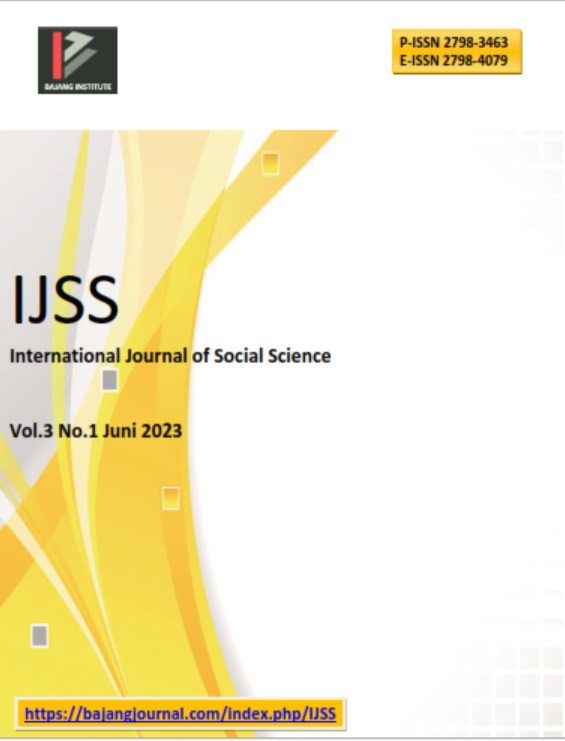STICKY COST BEHAVIOR OF INDONESIA STOCK EXCHANGE MANUFACTURING COMPANIES
DOI:
https://doi.org/10.53625/ijss.v3i1.5750Keywords:
Sticky Cost, Selling Cost, Administrative And General Expenses, Cost Of Goods SoldAbstract
When activity levels fluctuate, sticky costs tend to increase rather than decrease. The testing of a sticky cost model is used in this study to illustrate the behavior of sticky costs on the selling expenditures, general and administrative costs, and product costs that are incurred by manufacturing firms. This study makes use of secondary data collected from 164 industrial companies that were listed on the Indonesia Stock Exchange between 2018 and 2019. Multiple regression evaluated data. According to this study, selling expenses, administrative and general expenditures, as well as the cost of things sold, are all considered sticky costs. This finding confirms all previous forecasts
References
P. C. B. Ray H. Garrison, Eric W. Noreen, Managerial Accounting Akuntansi Manajerial Buku 1. Jakarta: Salemba Empat, 2008}
L. Ratnawati and Y. W. Nugrahanti, Perilaku Sticky Cost Biaya Penjualan, Biaya Administrasi dan Umum serta Harga Pokok Penjualan pada Perusahaan Manufaktur, J. Ekon. dan Bisnis, vol. 18, no. 2, pp. 65–80, 2016, doi: 10.24914/jeb.v18i2.314}
K. A. Krisnadewi, B. Niroula, and S. K. Singh, “Research on Cost Stickiness in International Journals: A Bibliometric Study,” AKRUAL J. Akunt., vol. 13, no. 2, pp. 144–158, 2021, doi: 10.26740/jaj.v13n2.p144-158.
D. Weiss, “Cost Behavior and Analysts’ Earnings Forecasts,” Account. Rev., vol. 85, no. 4, pp. 1441–1471, 2010, [Online]. Available: https://www.jstor.org/stable/20744165?seq=1}
R. Balakrishnan and T. S. Gruca, “Cost stickiness and core competency: A note,” Contemp. Account. Res., vol. 25, no. 4, pp. 993–1006, 2008, doi: 10.1506/car.25.4.2}
B. J. G. Argiles, J. M., “Cost Revisited: Empirical Application for Farms.,” J. Financ. Account., vol. 38, no. 144, pp. 579–605, 2009}
J. N. Cannon, “Determinants of ‘Sticky Costs’: An Analysis of Cost Behavior using United States Air Transportation Industry Data,” Account. Rev., vol. 89, no. 5, pp. 1645–1672, 2014, [Online]. Available: https://www.jstor.org/stable/24468379}
M. Porporato and E. M. Werbin, “Active Cost Management in Banks: Evidence of Sticky Costs in Argentina, Brazil and Canada,” 2010. doi: 10.2139/ssrn.1659228}
S. N. J. Mark C Anderson, Rajiv D Banker, “Are Selling, General, and Administrative Costs ‘Sticky’?,” J. Account. Res., vol. 41, no. 1, 2003, [Online]. Available: https://onlinelibrary.wiley.com/doi/abs/10.1111/1475-679X.00095}
O. R. de Medeiros and P. D. S. Costa, “Cost Stickiness in Brazilian Firms,” SSRN Electron. J., pp. 1–14, 2011, doi: 10.2139/ssrn.632365}
D. S. He, J. Teruya, and T. Shimizu, “Sticky Selling, General, and Administrative Cost Behavior and Its Changes in japan,” Glob. J. Bus. Res., vol. 4, no. 4, pp. 1–10, 2010, [Online]. Available: https://papers.ssrn.com/sol3/papers.cfm?abstract_id=1871276}
F. B. Windyastuti, “Analisis Perilaku Kos : Stickiness Kos Pemasaran, Administrasi dan Umum pada Penjualan Bersih (Studi Empiris Perusahaan yang Terdaftar di BEJ),” 2005, pp. 667–675, [Online]. Available: https://smartaccounting.files.wordpress.com/2011/03/kamp-07.pdf}
C. Subramaniam and M. W. Watson, “Additional evidence on the sticky behavior of costs,” 2003. doi: 10.1108/S1474-787120150000026006}
W. E. Paskah Ika Nugroho, “Do the Cost Stickiness in the Selling , General and Administrative Costs Occur in Manufacturing Companies in Indonesia ?,” 2013, pp. 2705–2721, [Online]. Available: http://lib.ibs.ac.id/materi/Prosiding/SNA XVI/makalah/sesi 3.pdf}
I. J. Hidayatullah, “Analisis Perilaku Sticky Cost dan Pengaruhnya terhadap Prediksi Laba Menggunakan Model Cost Variability dan Cost Stickiness pada Emiten di BEI untuk Industri Manufaktur,” 2011}
A. Hassanein and M. Younis, “Cost Stickiness Behavior and Financial Crisis: Evidence from the UK Chemical Industry,” Corp. Ownersh. Control, vol. 17, no. 2, pp. 46–56, 2020, doi: 10.22495/cocv17i2art4}
S. Abdelsalam Mustafa, “Sticky Cost Drivers: An Analytical Study of Cost Stickiness’ Causes,” Sci. J. Financ. Commer. Stud. Res., vol. 3, no. 2, pp. 291–326, 2022, doi: 10.21608/cfdj.2022.229761}
M. D. Restuti, L. Gani, E. R. Shauki, and L. Leo, “Does Managerial Ability Lead to Different Cost Stickiness Behavior? Evidence from ASEAN Countries,” Int. J. Financ. Stud., vol. 10, no. 3, pp. 1–21, 2022, doi: 10.3390/ijfs10030048}
T. K. Yasukata, K., “Are ‘Sticky Costs’ the Result of Deliberate Decision of Managers?,” Kobe, Japan, 2011.
J. Robert E. Lucas, “Adjustment Costs and the Theory of Supply,” J. Polit. Econ., vol. 75, no. 4, pp. 321–334, 1967, [Online]. Available: https://www.jstor.org/stable/1828594}
S Nakamura, “An Adjustment Cost Model of Long‐Term Employment in Japan,” J. Appl. Econom., vol. 8, no. 2, pp. 175–194, 1993, [Online]. Available: https://onlinelibrary.wiley.com/doi/epdf/10.1002/jae.3950080206}
L. Danizger, “Adjustment Costs, Inventories and Output,” Scand. J. Econ., vol. 110, no. 3, pp. 519–542, 2008, [Online]. Available: https://onlinelibrary.wiley.com/doi/abs/10.1111/j.1467-9442.2008.00549.x}
J. M. Argilés-Bosch, J. Garcia-Blandón, and D. Ravenda, Cost Behavior in e-commerce Firms, no. December 2021. Springer US, 2021}
R. E. Malcom, “Overhead Control Implications of Activity Costing,” Account. Horizons, pp. 69–78, 1991.
S. J. Mark Anderson, Rajiv Banker, Rong Huang, “Cost Behavior and Fundamental Analysis of SG&A Costs,” 2006. doi: 10.1016/j.spre.2005.12.003}
D. W. I. Kama, “Do Managers ’ Deliberate Decisions Induce Sticky Costs ?,” 2011. [Online]. Available: https://en-coller.tau.ac.il/sites/nihul_en.tau.ac.il/files/WP_16-2011_Kama_Weiss.pdf}
A. J. Serdaneh, “The Asymetrical Behavior of Cost: Evidence from Jordan,” J. Int. Bus. Res., vol. 7, no. 8, 2014}
E. Pamplona, C. Fiirst, T. B. de J. Silva, and V. C. da S. Zonatto, “Sticky Costs in Cost Behavior of the Largest Companies in Brazil, Chile and Mexico,” Contaduría y Adm., vol. 61, no. 4, pp. 682–704, 2016, doi: 10.1016/j.cya.2016.06.007}
H. Setiawan, “Penerapan Perhitungan Harga Pokok Produksi dalam Kaitannya dengan Pelaporan Keuangan pada PT Alas Seni Kreasi Industri,” J. Ilm. Kesatuan, vol. 1, no. 10, 2008}
M. Zanjirdar, Z. Madahi, and P. Khaleghi Kasbi, “Comparative Analysis of Sticky SGA Costs and Cost of Goods Sold: Evidence from Tehran Stock Exchange,” Manag. Sci. Lett., vol. 4, pp. 521–526, 2014, doi: 10.5267/j.msl.2014.1.014}
H. Chang, X. Dai, E. Lohwasser, and Y. Qiu, “Organized Labor Effects on SG&A Cost Behavior*,” Contemp. Account. Res., vol. 39, no. 1, pp. 404–427, 2022, doi: 10.1111/1911-3846.12737}
Downloads
Published
How to Cite
Issue
Section
License
Copyright (c) 2023 Magdalena Nany, Kristyana Dananti, Priskilla Oktavia, Sundari Sundari

This work is licensed under a Creative Commons Attribution 4.0 International License.

















